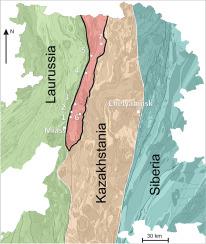Gondwana Research ( IF 7.2 ) Pub Date : 2021-01-08 , DOI: 10.1016/j.gr.2021.01.001 Elena S. Sorokina , Roman E. Botcharnikov , Yuri A. Kostitsyn , Delia Rösel , Tobias Häger , Mikhail A. Rassomakhin , Nataliya N. Kononkova , Alina V. Somsikova , Jasper Berndt , Thomas Ludwig , Elena V. Medvedeva , Wolfgang Hofmeister

|
Metamorphic gem corundum (mainly ruby) deposits are robust indicators of continent-continent collision processes. However, a systematic link of primary magmatic blue sapphire occurrences to orogenic belts is less understood. An example is the Ilmenogorsky alkaline complex, within the Ilmen Mountains region and part of the Uralian orogenic belt. The mobile belt is a product of the collision among Kazakhstania, Laurussia, and Siberia continents prior to the closure of the Paleo-Uralian ocean and formation of the Laurasia supercontinent (330–250 Ma). It is believed that the alkaline complex became inсluded into the separate Sysertsk-Ilmenogorsk microcontinent with unconstrained borders, when sandwiched between Kazakhstania and Laurussia during that collision. Paleo-reconstructions illustrate that magmatic and metasomatic sapphire deposits linked to alkaline magmatism trace the natural boundary of the “lost” microcontinent with a high precision. The syenite pegmatites of alkaline complex carried unusually large corundum-blue sapphire megacrysts that have recorded the multi-stage development of the Ilmenogorsky complex. The deposits were formed at about 275–295 Ma ago as reconstructed by in situ LA-ICP-MS U–Pb zircon dating. This formation stage corresponds to a broader continental collision process followed by the formation of Uralian orogeny in the area of the Ilmenogorsky complex. One pegmatite deposit, the “298” mine, is characterized by the occurrence of unusually large corundum megacrysts. The analyses of Rb–Sr isotopic system in the rocks from this deposit revealed two isochrons at 249 ± 2 Ma and 254 ± 22 Ma implying a late stage modification of original pegmatites. The timing of this stage corresponds to the limited post-collision stretching time. Hence, corundum-blue sapphire studied from magmatic (syenites) and metasomatic rocks linked to alkaline rocks in Uralian orogen suggests as a promising indicator for constraining the timing of continent-to-continent collision processes.
中文翻译:

蓝宝石岩浆岩追踪古大陆间的边界:以俄罗斯乌拉尔碰撞带伊尔默诺戈尔斯基碱性复合体为例
变质宝石刚玉(主要是红宝石)矿床是大陆-大陆碰撞过程的有力指标。但是,鲜为人知的是岩浆蓝宝石的原始发生与造山带的系统联系。一个例子是Ilmenogorsky碱性复合物,位于Ilmen山脉地区和乌拉尔造山带的一部分。移动带是古乌拉尔海域封闭和劳拉西亚超大陆(330-250 Ma)形成之前哈萨克斯坦,月桂和西伯利亚大陆之间碰撞的产物。据认为,在碰撞过程中,当夹杂在哈萨克斯坦和月桂之间时,碱性复合物被包含在边界不受限制的单独的Sysertsk-Ilmenogorsk微大陆中。古重建表明,与碱性岩浆作用有关的岩浆和变质蓝宝石矿床高精度地追踪了“遗失”微大陆的自然边界。碱性配合物的正长晶伟晶岩携带着异常大的刚玉蓝宝石蓝宝石大晶体,记录了伊尔莫诺戈尔斯基配合物的多阶段发展。沉积物形成于大约275–295 Ma之前,由原位LA-ICP-MS U–Pb锆石测年。这个形成阶段对应于更广泛的大陆碰撞过程,随后在伊尔默诺戈尔斯基地区形成了乌拉尔造山运动。一种伟晶岩矿床“ 298”矿床的特征是出现了异常大的刚玉大晶。该矿床岩石中的Rb-Sr同位素系统分析显示,在249±2 Ma和254±22 Ma处有两个等时线,这意味着原始伟晶岩的后期变质。该阶段的时间对应于有限的碰撞后拉伸时间。因此,从乌拉尔造山带中的岩浆(榴辉岩)和与碱性岩石相连的交代岩石中研究出的刚玉蓝宝石,可以作为约束大陆到大陆碰撞过程时间的有前途的指标。











































 京公网安备 11010802027423号
京公网安备 11010802027423号